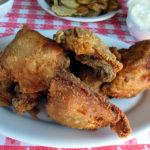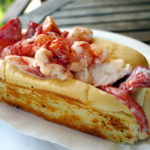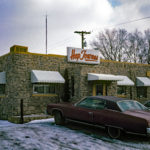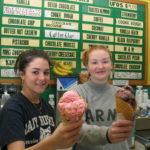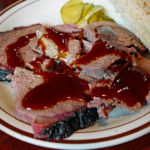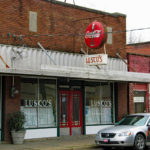Two For the Road
OUR FIRST DATE WAS OVER A WHITE-CLAM PIZZA at Pepe' s Pizzeria on Wooster Street in New Haven, Connecticut, and it was instantly apparent as we gazed into each other's eyes across the thin-crusted Neapolitan pie speckled with tiny, tender clams and frosted with olive oil, that we shared a passion for garlic. Our initial lust for each other was fueled by an orgy of lobster rolls, split hot dogs, Yankee Doodle Double Dandy Doodle Burger cheeseburgers, calzones, and cannoli.
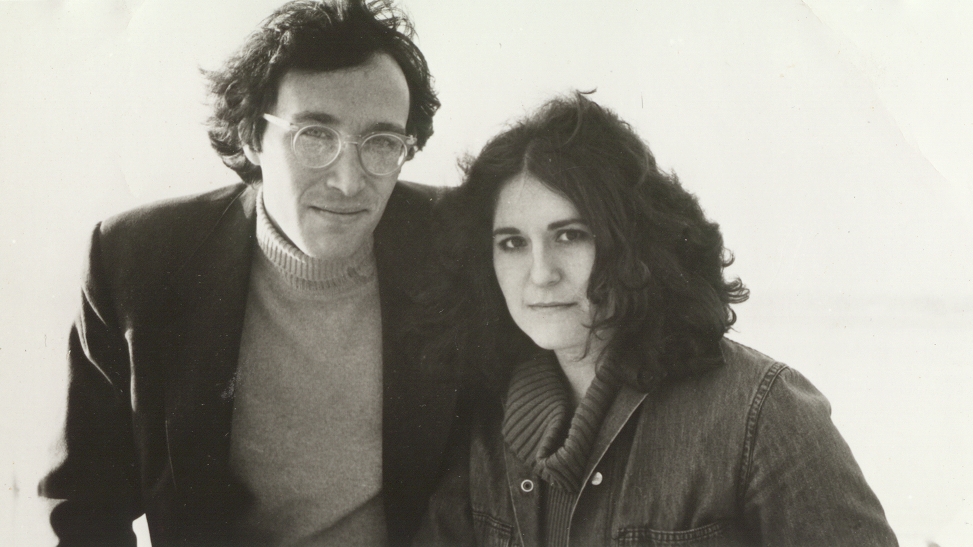
By Jane and Michael Stern
Originally Published 2006 Gourmet Magazine
OUR FIRST DATE WAS OVER A WHITE-CLAM PIZZA at Pepe’ s Pizzeria on Wooster Street in New Haven, Connecticut, and it was instantly apparent as we gazed into each other’s eyes across the thin-crusted Neapolitan pie speckled with tiny, tender clams and frosted with olive oil, that we shared a passion for garlic. Our initial lust for each other was fueled by an orgy of lobster rolls, split hot dogs, Yankee Doodle Double Dandy Doodle Burger cheeseburgers, calzones, and cannoli.
Michael had won a Woodrow Wilson Fellowship at Yale, where we had both gone to study art, so we had plenty of money to spend exploring restaurants up and down the Yankee shore. Compared to the average grad student, he was a high roller with a monthly stipend to squander. He also possessed what was, to Jane’s New York City sensibility, an amazing status symbol: a car. At 21, Jane had not yet learned how to drive. The car was our ticket to romance and eating adventures.
The fellowship money was diverted from expensive textbooks and art museum field trips to fund a comparative study of the pizzas made by Pepe’s, Sally’s, and The Spot in the old Italian neighborhood, as well as the Greek-style pizzas at Pizza House, which was less than 50 yards from our apartment. If pizza was our major interest, we minored in fried dough at summertime fairs, clams and chowder and lobsters all along the coast, and Yorkshire pudding at Mory’s, the Yalie dining club, where it was still possible to have a completely gelatinized meal, from aspic to Jell-O. Nearly every day, Michael had a choice to face: a seminar in medieval imagery in a dank basement lecture room in New Haven or a trip to the Rhode Island beaches with Jane for a shore dinner and a hot fudge sundae on ginger ice cream? Our passion for each other, and for finding things to eat, won out every time.
WE WERE MARRIED IN 1970, and a year later we got our degrees, which meant that the fellowship-subsidized grad school eating bonanza was coming to an end. We moved to a little shack in the woods of Guilford, Connecticut, where we didn’t even have a telephone. We were hiding out from life. Jane’s mother and father died of cancer within a year of each other. Her stepfather disinherited her. Her two favorite cousins died, and her aunt was institutionalized. In despair, Jane made the 15-mile drive into New Haven three times a week to stare at the index cards in the Yale Employment Center. Michael spent his time cultivating and smoking cannabis. After tens of thousands of dollars had been spent on our highfalutin educations, we realized we had little interest in pursuing what we had studied.
And so we did what generations had done before us. We hit the road. We had no idea when we did so that we were to become writers. We just wanted to get away from everything.
We proposed a book about truck-stop dining to a young editor, who thought it was a cute idea and gave us the princely advance of $2,500. We thought we had won the lottery. But after signing the contract, we froze. Who were we to write about food, even truck-stop food? Where did we come off, telling people what was good to eat? The notion that we had promised our publisher to write a coast-to-coast guidebook was overwhelming. We had pretty much never traveled anywhere. We had no knowledge of exactly where these marvelous truck stops were, scant experience writing, and no money beyond the first half of our advance.
We sat together at the kitchen table of our $99-per-month cabin trying to figure out what to do. The one-room shack where we lived might seem romantic if you saw it in the movies, but in real life it was hideously uncomfortable. After living there for nearly a year, we discovered a case of decomposing dynamite in the crawl space above the ceiling, left behind by a former tenant who was a 1960s radical. The gas stove was so old and decrepit that it once combusted and singed Jane’s eyebrows off as she checked on a roasting chicken. This home of ours was a good incentive for getting on the road.
We agreed on a plan: We would review every restaurant in America. This seemed not the slightest bit of a stretch to us. Not having traveled much, we looked at the Rand McNally map spread out on the kitchen table and could plainly see that America was a manageable place, no more than a foot and a half in length and composed of pretty pastel-colored states balanced on one another like building blocks.
Strategy well in place, we launched into part two of the plan: buying a suitable car for the journey. Just as buying a new handbag has always been Jane’s favorite antidote for whatever ails her, buying a car is Michael’s solution to just about any problem. Even Sigmund Freud would blush at the patent sexual symbolism of both objects, but we were too young and dumb to notice or care.
At a nearby car dealership, we met a salesman whose necktie we remember to this day, more than a quarter century later. Somehow this guy had managed to knot it absolutely flat, so that its front apron cascaded directly from his collar with no lump whatsoever, sort of like a sheet of molten polyester. As we told the salesman our needs and he touted the glories of the new ’75 Chevy line, we paid far more attention to his neckwear than to vehicular statistics. When we finally told him our budget, he became significantly less chummy, got up from his desk, and led us around to the back lot, where the less alluring and less expensive used vehicles were kept, out of sight of new-car shoppers. He pointed to a pre owned Chevrolet Suburban. Several body panels had been painted in a shop that didn’t worry much about matching the factory-original metallic color, so it had become a kind of rolling ode to all possible avocado hues, including even black (the hood). It was huge and it was ugly, something like a cross between a World War II tank and an over-the-hill Brady Bunch station wagon.
Jane grimaced at the sight of it. Michael tried to convince her that it had a rugged look, befitting the intrepid travelers we wanted to be. One thing the car did have in its favor was vast amounts of room inside. To save money in our travels, we planned to camp out in it, forgoing motel rooms.
“I’ll sew curtains and we can hang them on the back windows for privacy,” Jane said optimistically, never having sewn anything in her life.
“And it does have two air conditioners,” Michael noted. “We won’t be hot!”
By the time we wrote the check, we were certain that this heap would be a rather deluxe residence on wheels for the next two years.
The following morning, on the way to the grocery store, the left rear tire blew. And that summer gas prices doubled. We faced the first big gas crisis in a vehicle that got approximately eight miles to the gallon.
JANE HAD PLENTY OF TIME to sew curtains for the back windows, because five months into the research for Roadfood, we had not yet left Connecticut. In fact, we hadn’t even left New Haven County.
Yale had trained us to be meticulous in our research, and, ever the diligent academics, we commenced work on the guidebook by picking up the local Yellow Pages and opening to “Restaurants.” We began with those starting with the letter A. We ate at the Acropolis Diner and made notes about the good souvlaki. We went to Addie’s Café, where we didn’t much care for the hash browns, then on to Angela’s Pizzeria, where we thought the pepperoni pie was better than the sausage, and Archie Moore’s tavern, where the beer inevitably distracted us from our mission of sampling the menu.
At the end of five months we had gotten to Donat’s, an overreaching French restaurant where rich professors ate, and had yet to travel more than 20 miles from home. We envisioned the millennia that stretched out before we began reviewing restaurants in, say, Kansas.
Something was wrong with our plan.
“People will not take us seriously if we haven’t eaten everywhere,” moaned Jane, who, like so many writers, lives in constant fear that someone will discover she doesn’t know everything—or anything at all.
“Tough,” Michael responded. Jane thought he had a point.
We sat down at the kitchen table again, scrutinized the map, and came up with a new plan.
With a Magic Marker we drew a squiggly continuous line through 48 states. It would take a full two years and countless tanks of gas to travel this route, but at least we would finally get on the road. We would see all the pretty pastel states and eat in every one of them.
The new plan in place, we went shopping for supplies. We bought inflatable mattresses, sleeping bags, mosquito netting, snakebite kits, and everything else two urban Jews who had never slept anywhere but in a bed figured they would need to camp out. Jane added a portable oxygen tank to the stash of material, because she was convinced that she would not be able to breathe in mountainous states like Colorado.
We spent a whole day packing the Suburban with supplies to take us across the country and through all seasons. The lumpy calico curtains Jane had sewn for the backseat area made the car even uglier, if that was possible. We turned the skeleton key in the lock of our cabin door and drove away.
We sped west out of Connecticut over the Hudson River and into New Jersey. First stop: early lunch in a diner. Ah yes, a New Jersey diner! What could be a more excellent start to our adventure? Sadly, the food was mediocre; the mashed potatoes were made from a powdered mix. When we asked the waitress what kind of pie there was, she answered, “Red.” Sure enough, the slice we got was sweet, translucent red mucilage without even a hint of fruit. After three more unproductive stops at highway exit ramps, where we found rubbery chicken croquettes, a desiccated Philly cheesesteak, and cardboard-crusted pizza, our enthusiasm was waning. By the time we got to Maryland, it was suppertime.
We decided to spend our first night on the road at a place called Jellystone Park, one of a national chain of campgrounds that features a goofy image of Yogi Bear to welcome visitors. The place was filled with families in oversized motor homes with small cars tugged behind. Their immense recreational vehicles sprouted TV antennas and had golf carts and lawn chairs lashed to the roof. Many of them were plastered with decals proclaiming their owners’ membership in the Good Sam Club, meaning they were certifiably nice people—good Samaritans—who would pull alongside a wounded or disabled fellow traveler to offer help. On the backs of some of the big rolling homes, the owners had their names painted in florid script, generally using the errant apostrophe so common on mailboxes everywhere: “The Smith’s: Bill and Edna.”
The RV community took one look at our overgrown station wagon and turned their backs on us. They may have been Good Sams to one another, but we were clearly not in their league. We didn’t have a real motor home with a television and kitchen and wall-to-wall carpeting, and besides, the curtains Jane had stitched were flagrantly homemade. They hated us. We hated them.
“Don’t you just know those stupid Winnebagos are going to be clogging every superhighway from here to California,” Michael groused, imagining us at the end of a long line of motor homes traveling at 30 miles an hour from coast to coast; staring for weeks at the ass end of “The Smith’s: Bill and Edna ” It was at that moment that we vowed to travel only on back roads—a spur-of-the-moment decision that determined the path of our eating career.
The RV camp-out was the longest night of our lives. We tossed and turned on the clammy rubber air mattresses. The Suburban, which had seemed so big when it was empty, came to feel as claustrophobic as a mummy’s sarcophagus. Despite the mosquito netting, which had a habit of getting tangled around our legs, we were soon swatting at bugs the size of velociraptors, and when we had to pee in the middle of the night, we were too afraid to make the trek to the Jellystone restrooms, lest a bear eat us. We had snake bite kits and oxygen tanks, but we had forgotten to take along a flashlight.
We left at dawn in despair and sold all the camping junk at the first pawnshop we saw. We meandered south along back roads, finding nothing notable to eat. At twilight we were so tired that we pulled into the first roadside motel we came to, our culinary dreams dashed. Entering our unit, as the motel-keeper referred to the room, we blinked in awe at the modernity of a television set and a tiled shower stall, feeling a little like Ishi the Stone Age tribesman wandering out of the woods into civilization for the first time. We slept wonderfully, and when the sun rose in the morning, we were so happy not to be surrounded by huge, hostile motor homes that even our Suburban looked rather sleek and handsome.
We pushed a Merle Haggard eight-track tape into the slot, and as Merle serenaded us with songs of workin’ men, we cruised in the direction of the nearest little town on the map, at least ten miles away from the interstate.
It was a pretty south Virginia hamlet of clapboard houses with broad front porches. The rising sun cast the long shadows of ancient oak trees across tidy front lawns. An old man wearing overalls sat on a wooden chair and waved at us as we drove by his porch. We passed children riding their bikes in what we assumed was the direction of the schoolyard. We were traveling at bicycle speed ourselves, just taking in the sights.
“I smell biscuits,” Michael said, leaning his head out the open window and driving where his nose led him, toward a storefront café on the main street. Outside, the pickup trucks of customers were lined up on a diagonal, along with two local police cruisers. Pansies spilled forth from the bright blue flower boxes under the café windows.
There was not a single out-of-state license plate on the vehicles in the street except for ours.
DESPITE THE ACHE OF HUNGER, we hesitated as we stepped from our car into the street. This was the mid-1970s, and according to Easy Rider and Deliverance, it was them against us, and everyone who wasn’t us was a redneck with a shotgun aimed in our direction. At this point, no one would have mistaken Michael for a local farmer. His hair grazed his shoulders and he wore wire-rimmed glasses like John Lennon’s. Jane’s outfit included an embroidered peasant blouse and jangling earrings. We would have gone unnoticed at any eastern college campus coffeehouse, but suddenly we were nervous about going inside.
Our growling stomachs got the better of us. On the back wall, coffee cups hung on a pegboard, each one marked with the name of the customer to whom it belonged. A dozen men in work clothes sat at a big round table right at the front of the café, drinking from their personalized mugs, looking out the window, commenting on who was driving past, and trading news. Seated at other tables, men and women chatted back and forth to each other as in a home kitchen.
When the door swung closed behind us, all conversation stopped. We froze as every person in the café looked us up and down. In that long, long moment, we couldn’t help but notice the thick oval plates of ham and eggs and hot biscuits in front of nearly everybody in the place. The smell of peppery cream gravy, salt-cured country ham, and fresh-brewed coffee made us dizzy with hunger. Still, we didn’t dare make a move.
“There’s two seats over there,” a waitress called to us from behind the counter. We sat down fast on a pair of chrome-banded upholstered stools at a marble counter so old that it seemed to have an even row of indentations where decades of elbows had rested. Two non personalized coffee cups were placed in front of us, already filled. Slowly the hum in the room began to increase as the breakfasters reanimated.
The waitress stood before us, order pad in hand. “We don’t get too many strangers passing through here since the interstate was built,” she said, apparently aware of our discomfort. “We just ain’t never seen y’all before.”
Minutes after we ordered, the empty counter space in front of us filled with thick partitioned plates made of unbreakable blue plastic, the big partition holding ham and eggs, the two smaller ones containing grits and stewed apples. Four hot biscuits loosely wrapped in wax paper were nestled in a plastic basket. Little dishes held pats of butter, and glass ramekins were filled with wine-dark cherry preserves. Sold in Mason jars next to the cash register, they were made a few miles away. As we ate, we picked up the eight-page local newspaper that a previous counter sitter had left behind and read all about the potluck dinner that the Baptist church was having and about the damage done to Elroy Schmidt’s mailbox when the school bus accidentally backed into it. We read the frantic letter asking anyone who had seen Buck Thompson’s bluetick hound to please call the sheriff.
We ate until blissfully satisfied, and as we rose to pay at the cash register, a man also walking up to pay his bill stood aside, tipped his cap, and politely allowed Jane to proceed ahead of him. His harshly lined farmer’s face and sweat-darkened mesh work cap had seemed ominous when we entered, but this courtly gesture and his soft “Morning, ma’am” made us realize how off base our fears had been.
Out in the street, three other men were staring at our license plates. “Connect-tee-cut,” one of them said out loud, impressed by the jaw-breaking complexity of our home state’s name.
“That is some fine vehicle,” another said to Michael, who repressed the urge to sell him the Suburban on the spot.
“Thanks,” Michael said. “And that’s one nice café you have here. Good breakfast.”
“You come back soon,” they said as we got in and turned the key in the ignition.
We looked at each other and smiled. The biscuits and country ham had left a glow on our taste buds, and our spirits had been warmed by the community of people we had stumbled into. We gazed at the map of the U.S.A. with the squiggly route we had drawn all over it. The long line no longer seemed like a daunting task. Now it was a wide-open door.
Hungry for more, we drove on.
Discuss
What do you think of Two For the Road?
Related Articles
Stroud’s
By Jane and Michael Stern Originally Published 1995 Gourmet Magazine Chicken...
The Lobster Roll Honor Roll
Maine is the only state in America that features a picture of cooked food on its license...
Meat-And-Three
A few years back, country singer Ray Stevens invited a New York friend to join him at one of...
Top 12 favorite Ice Cream Scoops
WITH THE EXCEPTION of the hot dog bun, there has never been an edible invention as...
Top 5 BBQ Restaurants | Western Kentucky
Get yourself to Western Kentucky for great BBQ I see the food shows on TV where...
Best restaurants in Greenwood, MS | Hot Licks Delta Style
Ever since we first ate margarine-sauced pompano at Lusco’s, in Greenwood,...

